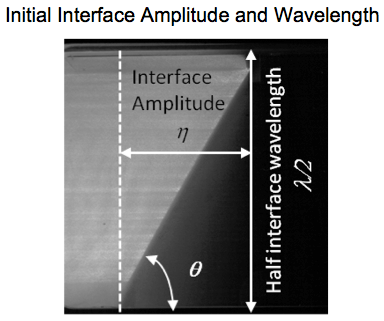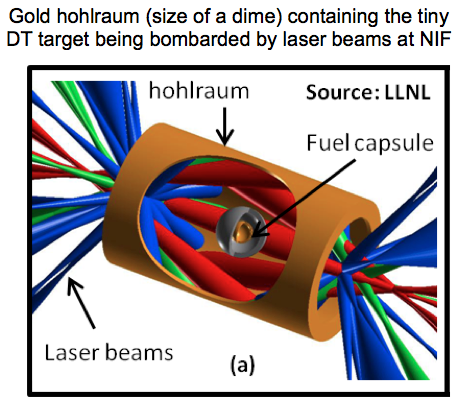Research ![]() Shock-Driven Mixing (Richtmyer Meshkov Instability)
Shock-Driven Mixing (Richtmyer Meshkov Instability)
Motivation: The National Academy of Engineering has identified “Provide Energy from Fusion” as one of the grand challenges for engineering. The National Ignition Facility (formally dedicated in May 2009) at the Lawrence Livermore National Laboratory (LLNL) is designed to drive inertial confinement fusion (ICF) capsules to ignition using both direct and indirect drive, in which laser energy (from 192 beams) is converted to thermal x-rays inside a cavity (hohlraum). This can be seen in the figure to the right.
The x-rays then ablate the outer layers of a Deuterium-Tritium (DT) filled capsule placed at the center of the hohlraum, leading to the formation of a convergent shock-wave, which drives the capsule to implode, compressing and heating the DT to the point of fusion condition. As the shock-wave traverses the solid capsule, the shock-induced turbulent mixing (due to the shock wave not being perfectly spherical and the capsule surface containing small-amplitude, high-wave number manufacturing imperfections) leads to the intermingling of the shell material with the fuel, which can severely degrade the energy yield from the fusion reaction. The goal of our research is to produce, diagnose, and simulate shock-driven turbulent flows in a compressible system which decouples hydrodynamic instabilities from the effects of radiation and plasma. This can be accomplished by observing structures over a sufficiently long time with spatial resolution that spans more than two orders of magnitude in space. In the case of the ICF system, an understanding of the physical mechanisms responsible for the onset and evolution of instabilities in the non-linear stages may allow engineers to design a more efficient fuel pellet capable of producing higher yield at lower driving energy.
Background: Compressible turbulence is ubiquitous in nature. Strong shock waves from explosions or collisions produce highly compressible flows in a wide variety of physical situations. In these scenarios, the shock wave propagates through a medium with non-uniform thermodynamic properties; where several coupled hydrodynamic processes occur simultaneously altering the geometry of the shock wave and the thermodynamic state of the medium. These processes include (1) shock-induced compression and heating; (2) shock-reflection, refraction and diffraction (or nonlinear-acoustic effects); and (3) vorticity production. The driving mechanism here is the baroclinic generation of vorticity [ Dω / Dt = (1 / ρ2) (∇ρ × ∇p) ] due to misalignment of the pressure and density gradients at the interface. After the passage of the initial shock wave, additional effects lead to further intensification and redistribution of the vorticity in the flow. The strength of these additional mechanisms varies widely with the incident shock wave Mach number, initial Atwood number, and acoustic impedance mismatch. When the magnitude of these effects is great, they can significantly alter the behavior of the flow, and strongly distort and complicate the evolution of the fluid interface, leading, often, to the growth of the features including secondary vortex rings, jetting, prominent and long-lived vortices, and regions of intense turbulent mixing. In extreme conditions, characterized by large Mach, Atwood and Schmidt numbers, the mixing process is highly inhomogeneous and characterized by multiple length scales and timescales depending on material properties. In most of the extreme mixing problems, the ability to mix materials is often contingent upon the state of turbulence or instabilities of the resident medium. Together with the shear-driven instability (Kelvin-Helmholtz, KH), the buoyancy-driven (Rayleigh-Taylor, RT) and shock-driven (Richtmyer-Meshkov, RM) instabilities are some of the fundamental, still open, problems of fluid mechanics.
Current Research: Here at STAML we intend to use our unique variable-inclination shock-tube facility equipped with state-of-the-art laser diagnostics techniques (Stereo-PIV, PLIF, Rayleigh-Scattering), to address the critical scientific questions associated with shock-driven variable-density flows in a configuration (shock-wave interacting with an inclined fluid interface, converging geometry) and regimes (1.5 < M < 3.0) which have not yet been explored. Such an experimental configuration would allow for experiments over a variety of Mach and Atwood numbers ranging from the classical RM instability to the compound RM/KH instability. This flexibility also allows experiments relevant to shock–turbulence interaction for broader impact in the compressible turbulence and hypersonic communities. During the shock passage through the interface between two gases, vorticity is, in general, deposited on the interface by means of baroclinic torque due to misalignment of the pressure and density gradients at the interface. In the case of an inclined interface problem, the amount of vorticity deposited on the initial interface, can be easily controlled by changing the inclination angle, without changing the Mach number (pressure gradient) or Atwood number (density gradient). This provides an easy-to-control, clean and repeatable interface for studying the RMI problem. An image of the initial inclined perturbation is provided in the sidebar of this page.


